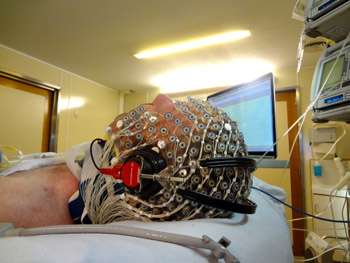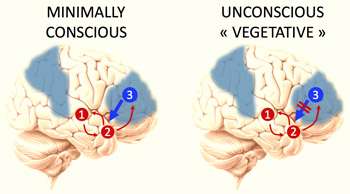May 13, 2011 report
New test may help distinguish between vegetative and minimally conscious state

(PhysOrg.com) -- In a new study published in Science, researchers from the University of Liege in Belgium, led by Dr. Melanie Boly, share the discovery of a new test that could aid physicians in differentiating between vegetative and minimally conscious states in patients with brain damage.
It is currently difficult to differentiate between a vegetative state where patients lack cognitive function yet display wakefulness and those in a minimally conscious state. Recent awareness to this issue arose in the Terri Schiavo case in Florida. Shiavo had been in a vegetative state for 15 years and on life support before a judge issued a court order to take her off life support. The question of brain function and the possibility of recovery was an issue in the court battle and this test could aid physicians in making that determination.
Using an electroencephalogram to record brain activity, Boly and her team looked at brain activity in 43 patients with 22 healthy individuals and 21 brain-damaged patients. The patients ranged in age from 16-83. Of the brain-damaged patients, 13 were in a minimally conscious state and 8 were in a vegetative state.

The subjects were played a series of tones, varying in pitch. With the change in pitch being a surprising event, the temporal cortex of the brain would send the frontal cortex a message for it to consider a reaction. This occurred in all of the subjects, regardless of the level of brain-damage. After the frontal cortex receives the message, it should send back a message to the temporal cortex. However, while this did occur in the healthy and minimally conscious patients, those in a vegetative state did not show that backwards communication.
Combined with the current Coma Recovery Scale, an assessment test currently administered to determine the level of consciousness, Boly hopes to be able to better distinguish between the actual level of consciousness.
More information: "Preserved feedforward but impaired top-down processes in the vegetative state" Boly M, Garrido MI, Gosseries O, Bruno MA, Boveroux P Schnakers C, Massimini M, Litvak V, Laureys S, Friston K, Science 13 May 2011. DOI: 10.1126/science.1202043
ABSTRACT
Frontoparietal cortex is involved in the explicit processing (awareness) of stimuli. Frontoparietal activation has also been found in studies of subliminal stimulus processing. We hypothesized that an impairment of top-down processes, involved in recurrent neuronal message-passing and the generation of long-latency electrophysiological responses, might provide a more reliable correlate of consciousness in severely brain-damaged patients, than frontoparietal responses. We measured effective connectivity during a mismatch negativity paradigm and found that the only significant difference between patients in a vegetative state and controls was an impairment of backward connectivity from frontal to temporal cortices. This result emphasizes the importance of top-down projections in recurrent processing that involve high-order associative cortices for conscious perception.
© 2010 PhysOrg.com















